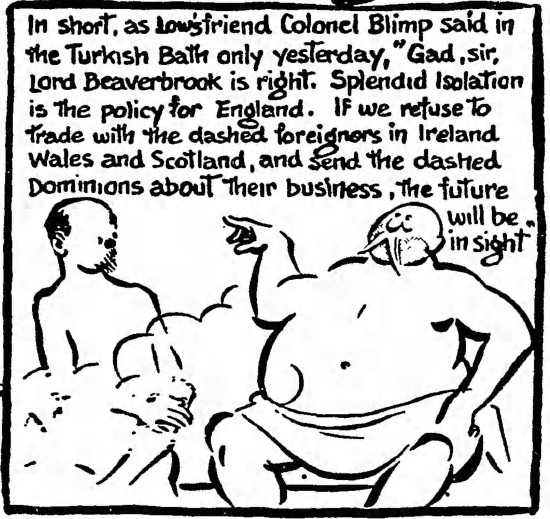The pejorative noun Blimp, more fully Colonel Blimp, designates a type of person with old-fashioned or reactionary opinions and a pompous and peremptory manner—cf. also meaning and origin of ‘Poona’ as applied to army officers.
It alludes to Colonel Horatio Blimp, the name of a cartoon character pictured as a rotund and pompous retired British army officer voicing a hatred of new ideas, invented by the New Zealand-born cartoonist and caricaturist David Alexander Cecil Low (1891-1963).
(The character’s surname was perhaps suggested by blimp, a noun of unknown origin, first recorded in 1916, denoting a small non-rigid airship.)
Colonel Blimp first appeared in Low’s Topical Budget, a weekly satirical cartoon feature in the Evening Standard (London, England), on Saturday 21st April 1934. The following is probably that first cartoon—it was published, “by arrangement with the “Evening Standard””, in The Manchester Guardian (Manchester, Lancashire, England) of Monday 23rd April 1934:
In short, as Low’s friend Colonel Blimp said in the Turkish Bath only yesterday, “Gad, sir, Lord Beaverbrook1 is right. Splendid Isolation is the policy for England. If we refuse to trade with the dashed foreigners in Ireland Wales and Scotland, and send the dashed Dominions about their business, the future will be in sight”
1 William Maxwell Aitken (1879-1964), 1st Baron Beaverbrook, was a Canadian-British newspaper publisher and politician; he bought the Evening Standard in 1923.
On Saturday 15th September 1934, “by arrangement with the “Evening Standard””, The Manchester Guardian (Manchester, Lancashire, England) published another cartoon by David Alexander Cecil Low. Entitled The New Member, this cartoon depicts a Russian delegate being welcomed at the League of Nations; beside him is an attaché case on which the words vulgar disarmament ideas are written. On the left-hand side, five men, all Colonel Blimp lookalikes, are watching the Russian; two of them are each holding a copy of a newspaper titled Anti-Bolsh News:
GENEVA BRANCH OF THE BLIMP FAMILY:
“Gad, sir—can’t think what the Committee is up to, lettin’ a Russian into the Club. The feller’s obviously no gentleman.
The earliest figurative use of Blimp that I have found is from the Middlesex County Times (Municipal Borough of Ealing, Middlesex, England) of Saturday 15th December 1934:
“BLIMP” OR BALDWIN?
TO THE EDITOR.
Sir,—Sir Frank Sanderson2 must, I suppose, be presumed to know his own electoral business best, but I shall be glad if you will give me space to say that there is at least one Ealing Conservative who will find it difficult, if not impossible, to vote for him at the next election. On both India3 and the Peace Ballot4 he has come down on the side of the Blimps. I had thought that Mr. Baldwin5 was his leader, as he is mine.—Yours, etc.,
J.
2 Frank Sanderson (1880-1965) was a British Conservative Party politician and public servant, Member of Parliament for Ealing from 1931 to 1950.
3 This is probably a reference to the Government of India Bill, which would pass into law in August 1935, and delivered increased self-government for India.
4 Carried out from November 1934 to June 1935 by the National Declaration Committee set up by the League of Nations Union, the Peace Ballot (official title: A National Declaration on the League of Nations and Armaments) was a nationwide questionnaire attempting to discover the British public’s attitude to the League of Nations and collective security.
5 Stanley Baldwin (1867-1947) was Leader of the Conservative Party from 22nd May 1923 to 28th May 1937, Prime Minister from 22nd May 1923 to 22nd January 1924 and from 4th November 1924 to 4th June 1929, Lord President of the Council from 24th August 1931 to 7th June 1935, Prime Minister from 7th June 1935 to 28th May 1937.



